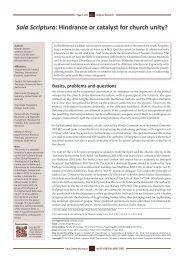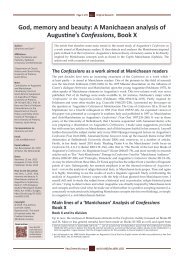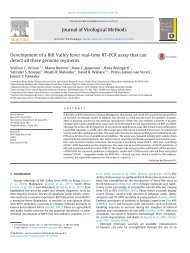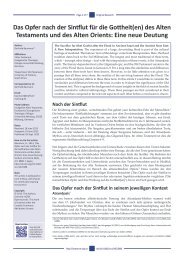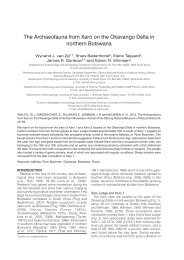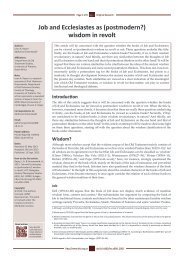Leviticus 10 and possible priestly power struggles - HTS Teologiese ...
Leviticus 10 and possible priestly power struggles - HTS Teologiese ...
Leviticus 10 and possible priestly power struggles - HTS Teologiese ...
You also want an ePaper? Increase the reach of your titles
YUMPU automatically turns print PDFs into web optimized ePapers that Google loves.
Page 3 of 7<br />
Original Research<br />
eine Desavouierung der Hegemonialansprüche derjenigen, die<br />
die Aarongeneologie als primäre Legitimationsgrundlage ihrer<br />
Ansprüche in Anschlag gebracht hatten. (Achenbach 2003:119)<br />
It seems as if he is taking a step backwards now, since he<br />
acknowledges that this narrative actually reflects badly<br />
on any <strong>priestly</strong> group which views itself as descendants of<br />
Aaron. Does this mean that if 1 Chronicles 24:1–19 traces<br />
Zadok as a descendent of Eleazar, then the Zadokite lineage<br />
is also tainted by the cultic failure described in <strong>Leviticus</strong><br />
<strong>10</strong>? Achenbach seems reluctant to say this outright, but<br />
his arguments leave this possibility open. This brings us to<br />
another scholar who interprets <strong>Leviticus</strong> <strong>10</strong> differently <strong>and</strong><br />
in favour of the Aaronides.<br />
Nihan<br />
Nihan follows Achenbach when it comes to the most<br />
important historical-critical issues. For Nihan (2007:576–<br />
607) Chapter <strong>10</strong> is the last chapter added to <strong>Leviticus</strong> <strong>and</strong><br />
he follows Achenbach when it comes to interpreting this<br />
text in relation to Numbers 16–17. <strong>Leviticus</strong> <strong>10</strong> was written<br />
after that text was finalised <strong>and</strong> all three layers were already<br />
united into one narrative. Thus in terms of what is often<br />
called diachronic issues the two are broadly in agreement,<br />
but Nihan’s interpretation of what the significance of this<br />
narrative is for Aaron <strong>and</strong> his descendants is totally different<br />
from Achenbach’s.<br />
Nihan (2007:576–579) starts by offering some ideas on the<br />
structure of the chapter <strong>and</strong> argues that the text is not as<br />
disjointed as historically-oriented critics have claimed before<br />
him. 11 For Nihan (2007:578) <strong>Leviticus</strong> <strong>10</strong> has a ‘clear narrative<br />
progression’ <strong>and</strong> he also identifies (following Hartley<br />
1992:129 & Staubli 1996:85) a chiastic structure in the chapter<br />
which could be summed up as follows:<br />
A. <strong>10</strong>:1–5 Transgression of cultic laws by Aaron’s elder sons,<br />
sanctioned.<br />
B. <strong>10</strong>:6–7 Instruction by Moses to Aaron <strong>and</strong> his two<br />
remaining sons<br />
X. <strong>10</strong>:8–11 Instruction by Yahweh to Aaron alone<br />
B’. <strong>10</strong>:12–15 Instruction by Moses to Aaron <strong>and</strong> his two<br />
remaining sons<br />
A’. <strong>10</strong>:16–20 Transgression of cultic laws by Aaron’s younger<br />
sons, not sanctioned. (Nihan 2007:579)<br />
Previously <strong>Leviticus</strong> <strong>10</strong>:12–15 <strong>and</strong> <strong>10</strong>:16–20 had been regarded<br />
as belonging to a later layer, but for Nihan (2007:577–578)<br />
despite the fact that they take us back to the previous chapter<br />
<strong>and</strong> beyond what happened in <strong>10</strong>:1–5, the chapter could still<br />
be read as one.<br />
Like many other scholars before him, Nihan (2007:580–583)<br />
also asks what ֵא֣ ׁש ז ָ ָ֔רה [strange fire] refers to <strong>and</strong>, of course,<br />
what Nadab <strong>and</strong> Abihu did wrong? For Nihan (2007:582) the<br />
answer lies in verse 1 in the clause ‘it was not comm<strong>and</strong>ed<br />
by Yahweh.’ The ritual performed by Nadab <strong>and</strong> Abihu was<br />
11.The best example of an older view is that of Gerstenberger (1993:<strong>10</strong>5), who argues<br />
that the chapter ‘fehlt thematisch wie stilistisch jede Einheitlichkeit.’<br />
not comm<strong>and</strong>ed in the first nine chapters of <strong>Leviticus</strong> <strong>and</strong><br />
that raises the question why censer-incense offering is not<br />
mentioned in these chapters. The answer (for Nihan) lies in<br />
the other two texts in the Pentateuch which refer to censers<br />
being used in worship: <strong>Leviticus</strong> 16:12–13 <strong>and</strong> Numbers<br />
17:6–15. These two texts state that the only person who could<br />
execute this ritual was the high priest. In this regard Nihan<br />
does not differ much from Achenbach. Nihan (2007:584)<br />
continues that <strong>Leviticus</strong> <strong>10</strong> <strong>and</strong> Numbers 16–17 share this<br />
doctrine that censer-incense offering is ‘a privilege reserved<br />
for the high priest’ <strong>and</strong> that <strong>Leviticus</strong> <strong>10</strong> anticipates the story<br />
of Numbers 16–17. 12 Nihan (2007:585) also acknowledges<br />
that the editors of the Torah had to address the issue of<br />
censer-incense offering because of the growing popularity<br />
‘of this type of offering in Persian-period Yehud.’ For Nihan<br />
(2007:585) there is a clear connection between <strong>Leviticus</strong><br />
16:12–13, <strong>Leviticus</strong> <strong>10</strong> <strong>and</strong> Numbers 16–17, since ‘in the entire<br />
Torah only these three passages mention censer-incense.’<br />
Furthermore, for Nihan (2007:586), when the story of<br />
Nadab <strong>and</strong> Abihu is read in the context of <strong>Leviticus</strong> 1–<strong>10</strong>,<br />
it becomes a didactic story the objective of which is to teach<br />
the ‘necessity of complete observance of Yahweh’s laws, as<br />
well as the consequences of disobedience.’ In this regard he<br />
follows Levine (1989:38).<br />
It is safe to say that up to now Nihan agrees to a large extent<br />
with Achenbach. The strange fire incident had something<br />
to do with the fact that only the high priest was allowed<br />
to bring incense offerings. Nihan also acknowledges some<br />
Persian influence, but he is much more careful in this regard<br />
than Achenbach. Nihan differs from Achenbach about the<br />
fact that the fire was not from the altar. For Nihan (2007:581)<br />
this issue is really not that significant. With regard to the<br />
diachronic issues of how <strong>Leviticus</strong> <strong>10</strong> is related to Numbers<br />
16–17 <strong>and</strong> other relevant texts in the Pentateuch, they are<br />
mostly in agreement.<br />
One of the main differences between Achenbach <strong>and</strong> Nihan<br />
has to do with the way in which they portray the dynamic<br />
between <strong>Leviticus</strong> <strong>10</strong> <strong>and</strong> the <strong>priestly</strong> torot in Ezekiel 44:20–23.<br />
This discussion is obviously about <strong>Leviticus</strong> <strong>10</strong>:8–11, which is<br />
in the middle of the chiastic structure identified above <strong>and</strong><br />
is one of only two texts in the Pentateuch where Aaron is<br />
directly addressed by YHWH <strong>and</strong> Moses is excluded. Nihan<br />
(2007:592) carefully analyses the differences between <strong>10</strong>:8–11<br />
<strong>and</strong> Ezekiel 44 <strong>and</strong> argues that ‘in two respects, Lev <strong>10</strong> goes<br />
beyond Ez 44.’<br />
Firstly Nihan (2007:592) argues that in Ezekiel 44:21 we<br />
find the comm<strong>and</strong> that priests need to be sober when they<br />
perform their duties <strong>and</strong> in verse 23 we find the comm<strong>and</strong><br />
that priests are to teach ירה) Hif) the difference between holy<br />
<strong>and</strong> profane <strong>and</strong> to show ידע) Hif) the difference between<br />
12.Nihan (2007:584–585) notes that one would have expected that the sons of<br />
Aaron’s older brother would have removed the bodies of Nadab <strong>and</strong> Abihu. This<br />
means his brother Yizhar, but his first son is Korah, who is one of the culprits in<br />
Numbers 16. The fact that the sons of Aaron’s younger brother Uzziel are called<br />
upon to do this means, that the author already knows that Korah is out of the loop.<br />
For Nihan <strong>Leviticus</strong> <strong>10</strong> is thus contemporary with or later than the last edition of<br />
Numbers 16–17.<br />
http://www.hts.org.za<br />
doi:<strong>10</strong>.4<strong>10</strong>2/hts.v69i1.1990



